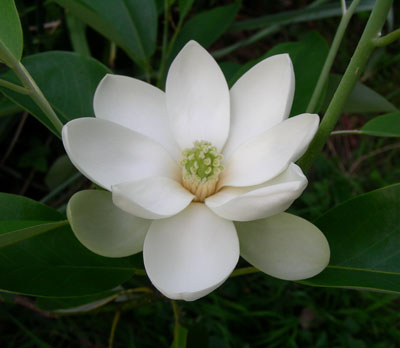Sweetbay
Magnolia virginiana
Family: Magnoliaceae
Natural History

Flower of sweetbay in late spring | Photo credit: Flickr user rachelgreenbelt. | Used under a Creative Commons license
Sweetbay magnolia is also called sweetbay, swampbay, or swamp magnolia. This tree is often grown as an ornamental landscape tree because of its attractive foliage, flowers, and fruit. It occurs naturally in moist and wet soils in wetland areas such as swamps and along streams and ponds. Sweetbay sprouts freely after a fire and can form thickets.
Introduced into European gardens as early as 1688, the sweetbay magnolia was known as the beavertree by colonists, who caught beavers in traps baited with the fleshy roots. Deer and cattle are also fond of the trees and frequently browse on the leaves and twigs. The vegetation may comprise as much as 25% of some cattle's diets during winter months. The fruits provide a good food source many wildlife including gray squirrels, small rodents, wild turkey, quail, and numerous songbirds.
The aromatic wood of sweetbay is soft, even-grained and easy to work. It is used for veneer, boxes, containers, furniture, and some lumber and pulpwood.
Sweetbay is found from New York to Florida and west to Texas, Arkansas, and Tennessee at elevations up to 500'. It is most commonly found in South Carolina, Alabama, Georgia, and Florida.
